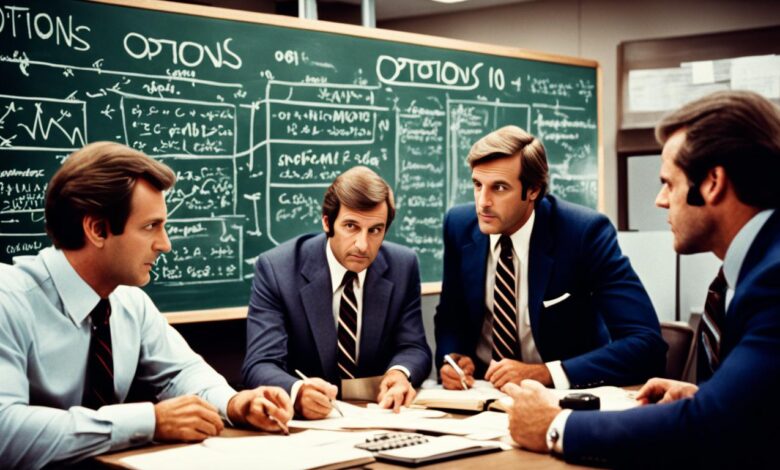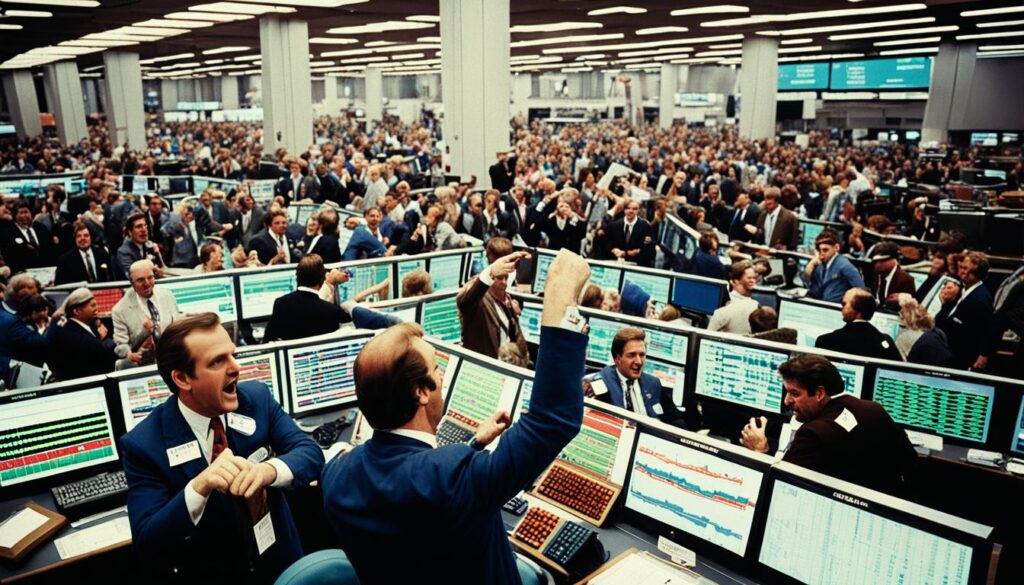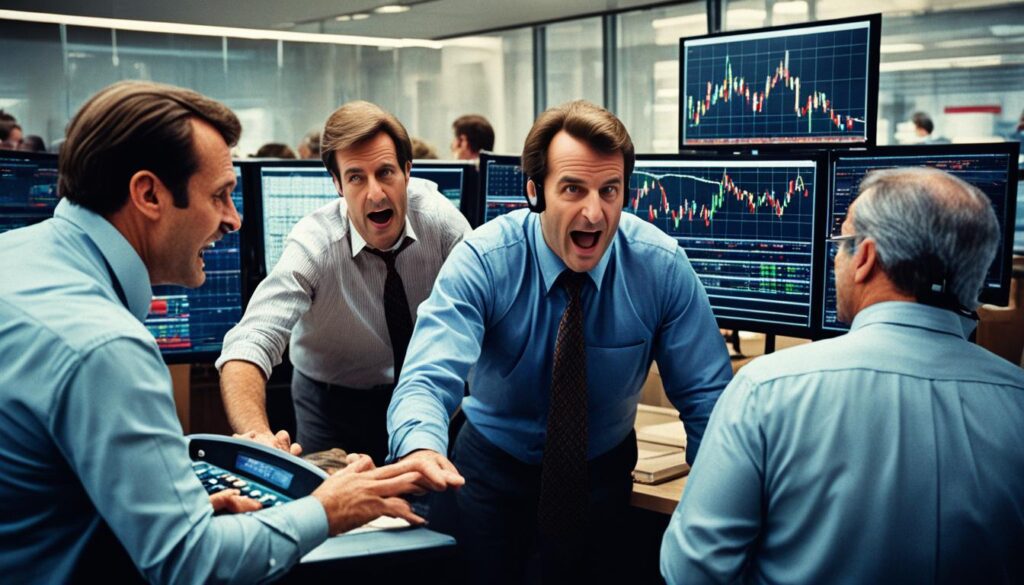Options Trading in the 1970s – A Look Into The Past

I’m taking a trip down memory lane to explore the fascinating world of options trading in the 1970s. This decade was a turning point in finance. It saw a big leap in trading innovation that changed finance’s future.
Back then, only a small fraction of Americans owned stocks. In the 1950s, just 4.2% of the U.S. population held common stocks. By the 1970s, things were changing fast. The creation of Individual Retirement Accounts (IRAs) in 1974 and the first index fund in 1976 sparked a new interest in mutual funds.
The decade wasn’t all smooth sailing for investors. The Dow Jones Industrial Average (DJIA) gained only about 5% over the entire period. Yet, this challenging environment led to big changes in finance and trading practices.
As we delve deeper into the era of bell-bottoms and disco, we’ll uncover how the 1970s set the stage for modern options trading. The story of financial innovation during this time is as captivating as it is crucial to understanding today’s markets.
The Birth of Modern Options Trading
The 1970s were a key time for finance with the start of modern options trading. This period changed the financial markets a lot.
Establishment of the Chicago Board Options Exchange (CBOE)
In 1973, the Chicago Board Options Exchange (CBOE) opened. It was the first place in the U.S. for options trading. This big change changed how investors handled risks and made bets.

Introduction of Standardized Options Contracts
The CBOE brought in standardized options contracts, a big deal for finance. These contracts made trading easier for everyone. By 1977, the CBOE listed options on individual stocks, opening up more trading chances.
Impact on Financial Markets
Standardized options and the CBOE changed financial markets a lot. Options trading moved from a simple risk tool to a complex financial product. It gave new ways to manage risks, bet on market trends, and make money.
“Options trading has transformed from a niche market to a cornerstone of modern finance, providing investors with unprecedented flexibility and opportunities.”
This innovation led to more changes, like electronic trading in the 1980s. It made options trading even better. Today, options trading is for many investors, from big institutions to individual traders.
Regulatory Framework and the Creation of the CFTC
The 1970s brought big changes to the regulation of futures and options markets. This was the start of a new time in financial oversight with the creation of the Commodity Futures Trading Commission (CFTC).
Commodity Futures Trading Commission Act of 1974
The CFTC Act of 1974 changed everything. It made the CFTC an independent agency, covering more than just agricultural commodities. This law gave the CFTC wide powers over futures trading in all commodities.
CFTC’s Expanded Regulatory Powers
With its new authority, the CFTC could watch over a broader range of financial tools. It could approve new contracts, check on trading, and enforce rules against market tricks.

Transition from Commodity Exchange Authority
On April 21, 1975, the CFTC took over from the Commodity Exchange Authority. This change ended one era and started a new, more detailed way of regulating futures markets.
| Year | Event |
|---|---|
| 1974 | CFTC Act signed |
| 1975 | CFTC begins operations |
| 1975-1980 | Expansion of regulatory oversight |
The creation of the CFTC started a new era of market regulation. Its wide powers and detailed oversight helped shape the futures and options markets we see today.
Options Trading in the 1970s: A Decade of Innovation
The 1970s were a big change for options trading. They brought new financial tools and changed the market. I saw how trading strategies quickly changed during this important time.
In 1975, the first futures contract on U.S. government debt was introduced. This big step changed the financial world. It opened up more ways to trade and manage risks. Then, in 1977, the Chicago Board of Trade added U.S. Treasury bond futures contracts. This made the options market even bigger.

Options trading grew a lot during this time. People started using new strategies to deal with tough economic times. They were trying to protect themselves from risks in a shaky economy.
| Year | Innovation | Impact |
|---|---|---|
| 1975 | First futures contract on U.S. government debt | Expanded trading opportunities |
| 1977 | Introduction of U.S. Treasury bond futures | Diversified options market |
| 1970s | Rise of data analytics in trading | Improved decision-making processes |
This decade saw a big move towards using math and data to make trading better. This move helped create the trading strategies we use today. It also shaped how the market develops.
Key Milestones in Options and Futures Markets
The 1970s were a big change for options and futures markets. I saw major steps that changed the financial world we see today.
First Futures Contract on U.S. Government Debt
In 1975, the Chicago Mercantile Exchange launched the 90-Day U.S. Treasury bill futures contract. This was a big step for managing interest rate risks by financial institutions.
Introduction of Treasury Bond Futures
The Chicago Board of Trade introduced U.S. Treasury bond futures in 1977. This move let investors protect against long-term changes in interest rates. It changed how people managed their investments.

Emergence of Commodity Pool Operators and Trading Advisors
The late 1970s brought more commodity pool operators and trading advisors. By 1979, the CFTC set rules for these professionals. This made the market safer and protected investors better.
| Year | Milestone | Impact |
|---|---|---|
| 1975 | 90-Day Treasury Bill Futures | Improved short-term interest rate risk management |
| 1977 | Treasury Bond Futures | Enhanced long-term interest rate hedging |
| 1979 | CFTC Rules for CPOs and CTAs | Professionalized commodity trading industry |
These events set the stage for today’s financial derivatives market. Treasury bill and bond futures opened new ways to manage risks and speculate. At the same time, commodity trading advisors added expertise and sophistication to the markets.
Challenges and Market Emergencies in the Late 1970s
The late 1970s were tough times for options trading. I saw how market manipulation and rules changes affected the era. The Commodity Futures Trading Commission (CFTC) had to act fast to handle emergencies.
In 1976, the May Maine potato contract on the New York Mercantile Exchange failed. This showed the need for better oversight in futures markets. The CFTC quickly stepped in to fix the issue and stop it from happening again.
Market manipulation was a big worry back then. The CFTC took a strong stance against the Hunt family for breaking rules in soybean futures. This move showed the Commission’s dedication to fair and clear markets.
In 1979, the CFTC closed the Chicago Board of Trade March wheat futures contract. This was to stop price manipulation and keep the market honest. Such actions became more common as the decade went on.
| Year | Event | CFTC Action |
|---|---|---|
| 1976 | May Maine potato contract default | Emergency intervention |
| Late 1970s | Hunt family exceeds soybean futures limits | Regulatory action |
| 1979 | Chicago Board of Trade wheat futures concerns | Contract closure |
These challenges showed how crucial strong rules are for options trading. The CFTC’s actions set the stage for a more stable market and better protection for investors.
The Economic Backdrop: Inflation, Stagflation, and Market Volatility
The 1970s were tough times for the United States’ economy. It faced a mix of high inflation, stagflation, and market ups and downs. Unemployment rates went way up, hitting over 10% by the late 1970s.
Inflation was out of control, hitting 14% by 1980. The Federal Reserve, led by Paul Volcker, took bold steps to fix this. They raised interest rates almost to 20%, with the prime rate over 21% at its highest.
Everyone was unsure about the market. The stock market fell by almost half in just 20 months. This led to a big increase in options trading as people looked for ways to handle risks and make money from market changes.
“The 1970s economic rollercoaster pushed options trading to new heights, as traders navigated through uncharted waters of stagflation and market instability.”
The Federal Reserve’s actions greatly affected options trading. Treasury bonds became key in trading portfolios, helping protect against inflation and market ups and downs. Even with these challenges, the economy showed strength, with real GDP growth over 5% in some years.
| Year | Inflation Rate | Unemployment Rate | Interest Rate |
|---|---|---|---|
| 1973 | 8.8% | 4.9% | 7.5% |
| 1975 | 9.1% | 8.5% | 7.9% |
| 1980 | 14.0% | 7.1% | 20.0% |
This economic situation led to big changes in financial markets. It influenced options trading and market trends for many years ahead.
The Legacy of 1970s Options Trading
The 1970s changed options trading forever, setting the stage for today’s financial markets. Innovations from that decade still guide our trading today. On April 26, 1973, Cboe opened, bringing standardized options contracts to the market. This move changed over-the-counter trades to a centralized market, thanks to Joe Sullivan’s vision.
The 1970s brought big changes in rules for trading. The Commodity Futures Trading Commission (CFTC) was created in 1974. By 2002, the derivatives market had grown to $106 trillion, reaching $531 trillion later on. This shows how crucial the ’70s rules were.
The decade was marked by economic ups and downs, like high inflation and market swings. Gold and silver prices skyrocketed, showing the need for better risk management tools. Options trading became key for handling these risks.
Looking at Cboe Global Markets today, I see the lasting effects of the 1970s. The rules, contracts, and market dynamics from back then still shape our financial world. They guide how we handle risks, innovate, and make markets more efficient in the 21st century.
FAQ
What was the significance of the establishment of the Chicago Board Options Exchange (CBOE) in the 1970s?
The CBOE started in the 1970s and changed options trading forever. It brought standardized options contracts to the market. This move helped grow options trading and changed financial markets.
What was the Commodity Futures Trading Commission (CFTC), and how did it impact the industry?
The CFTC began in 1974, taking over from the Commodity Exchange Authority. It got more power to watch over futures trading in all commodities. This big change in rules changed how the industry was overseen.
What were some of the key innovations in options and futures trading during the 1970s?
The 1970s brought new things to options and futures trading. For the first time, there was a futures contract for U.S. government debt. Commodity pool operators and trading advisors also started. Long-term U.S. Treasury bond futures contracts were introduced. These changes gave traders and investors more financial tools.
What challenges did the CFTC face in the late 1970s?
The CFTC had to deal with market emergencies in the late 1970s. For example, it handled the May Maine potato contract default on the New York Mercantile Exchange in 1976. The Commission also took on the Hunt family for breaking rules in soybean futures. It closed the Chicago Board of Trade March wheat futures contract to stop price manipulation.
How did the economic conditions of the 1970s, such as high inflation, stagflation, and market volatility, influence options trading strategies and market dynamics?
The 1970s were tough with high inflation, stagflation, and market ups and downs. These economic issues changed how people traded options and the market’s behavior. The Federal Reserve’s actions and the uncertainty of the time led to new financial tools and trading ways.
What was the lasting impact of the innovations and regulatory changes in options trading during the 1970s?
The 1970s brought big changes to options trading with the CFTC, standardized contracts, and new financial tools. These changes helped shape today’s financial markets. They set the stage for the ongoing growth of options and futures markets.